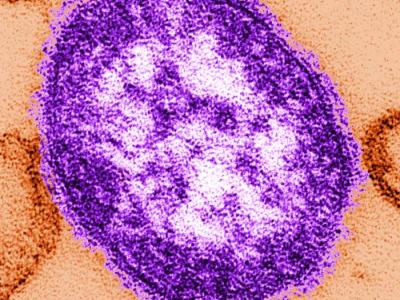Nov 28, 2006 (CIDRAP News) – Restaurants that have a certified kitchen manager (CKM) seem to have a lower risk of serving food that triggers infectious illnesses, according to a study comparing restaurants that were involved in disease outbreaks with those that were not.
"We were much less likely to find a certified kitchen manager in a restaurant that experienced an outbreak," said Craig W. Hedberg, PhD, lead author of the research report in the November issue of the Journal of Food Protection. He is an associate professor of environmental and occupational health in the University of Minnesota School of Public Health in Minneapolis.
Certified kitchen managers—those who have completed a food safety training course—are required in some states but not all, the researchers say.
Hedberg, along with researchers from the Centers for Disease Control and Prevention (CDC) and the University of Tennessee, examined 22 restaurants involved in disease outbreaks between June 2002 and June 2003 and 347 restaurants with no recent outbreaks. The study was a project of the CDC's Environmental Health Specialists Network (EHS-Net), which covers all or parts of nine states.
"This was the first systematic attempt to look at the environmental evaluations in restaurants with outbreaks and compare that to a large body of similar data from restaurants with no indication of any outbreak going on," Hedberg told CIDRAP News.
The researchers used a combination of interviews and direct observation to assess restaurant operations and policies related to food safety. Observers followed the preparation of certain food items, Hedberg said.
The EHS-Net specialists identified 107 restaurant-linked outbreaks in their areas (out of 179 outbreaks overall), but staff size limited the number investigated to 22. Nonoutbreak restaurants were defined as those with no history of outbreaks for the preceding 3 years and no complaints of food-related illness within the past year.
Outbreak and nonoutbreak restaurants were similar in many respects, but 71% of the nonoutbreak restaurants (243 of 347) had a CKM, versus 32% (7 of 22) of outbreak restaurants, the researchers found.
The findings "suggest that the presence of a CKM reduces the risk for an outbreak and was the major distinguishing factor between the outbreak and nonoutbreak restaurants," the report says. In particular, CKMs seemed to be associated with a lower risk of outbreaks linked to norovirus and Clostridium perfringens, two of the three most common outbreak pathogens. Also, bare-hand contact with food was less likely to be a factor in outbreaks in restaurants that had CKMs.
Most restaurants, regardless of outbreak history, relied on on-the-job food safety training for workers, the authors found. They surmised that CKMs probably improved the quality of this training, leading to less bare-hand contact with ready-to-eat foods and better control of food temperatures.
However, in restaurants with outbreaks, the presence of a CKM didn't seem to reduce the role of infected food handlers as contamination sources leading to the outbreaks, according to the report.
In addition, the researchers found that most restaurants had policies requiring food workers to report illnesses and barring staff members from working while sick, but those policies appeared to make little or no difference in the rate of outbreaks or in the role of infected food handlers as contamination sources. Most restaurants, both outbreak and nonoutbreak, did not offer sick leave for food workers.
The findings suggest that food safety training programs need to put more emphasis on managing food worker illnesses, the authors say. On the basis of previous studies on gastrointestinal illness, they estimate that 50,000 US food workers are likely to work while infected with norovirus.
Carol Selman of the CDC, senior author of the study, said the Food and Drug Administration (FDA) and the Conference for Food Protection, which advises the FDA, have recommended that all states require restaurants to have CKMs. She said the findings may help sway those who have been "on the fence" as to whether to adopt that requirement.
"It basically lent credence to what had been recommended by the FDA and the Conference for Food Protection," Selman told CIDRAP News. She is a senior public health advisor in the division of emergency and environmental health services of the CDC's National Center for Environmental Health in Atlanta.
However, while the findings suggest that CKMs may help prevent norovirus outbreaks, "the key determinant appears to be the presence of an infected food worker," the researchers write. "This conclusion must be confirmed by further studies involving a larger series of outbreaks."
Selman said EHS-Net is an offshoot of the CDC's Foodborne Diseases Active Surveillance Network, or FoodNet, which collects data on all laboratory-diagnosed cases of common foodborne diseases in all or parts of 10 states. EHS-Net includes at least one environmental health specialist and one epidemiologist in each participating state or area, she said.
Hedberg said EHS-Net was set up to help explain some of FoodNet's findings about exposure to foodborne pathogens, especially "a number of suggestions coming out of FoodNet that restaurants were playing an important role in the epidemiology of foodborne diseases."
Previous studies have failed to find consistent links between restaurant inspection results and disease outbreaks, the authors say. Their study was designed to identify both system failures that led to outbreaks and underlying reasons for the failures.
Hedberg CW, Smith SJ, Kirkland E, et al. Systematic environmental evaluations to identify food safety differences between outbreak and nonoutbreak restaurants. J Food Protection 2006 Nov;69(11):2697-702 [Abstract]


















